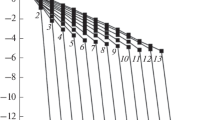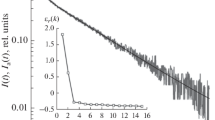Abstract
Time-resolved fluorescence anisotropy is an invaluable method for investigating the internal and rotational dynamics of biomolecules. The range of rotational motions detectable by anisotropy decay is limited by the fluorescence lifetime; typically, a depolarizing motion may be resolved if the associated correlation time is between 0.1 and 10 times the intensity decay lifetime. To extend that range and to improve the recovery of anisotropy decay parameters, a general analytical method has been developed. This procedure utilizes a modification of Lagrange multiplier methods to constrain the values of the iterated kinetic parameters during nonlinear least-squares analysis of anisotropy decay data. The form of the constraint equation is derived from the classic relationship between the decay parameters and the steady-state anisotropy, which can be simply and accurately measured. Application of the constraint to analyses of synthetic data sets increased the accuracy of recovery by decreasing the uncertainty in the iterated parameters. The constraint also enabled the accurate recovery of correlation times that were a factor of 30 greater than the fluorescence lifetime, although it did not improve recovery of correlation times that were much shorter than the lifetime. Using this technique, it should now be possible to characterize the dynamics of larger macromolecules and assemblies than those that can currently be studied by fluorescence anisotropy decay.
Similar content being viewed by others
REFERENCES
M. Badea and L. Brand (1979) Methods Enzymol. 61, 378–425.
Ph. Wahl (1979) Biophys. Chem. 10, 91–104.
M. L. Johnson and L. M. Faunt (1992) Methods Enzymol. 210, 1–36.
E. Waxman, W. R. Laws, T. M. Laue, Y. Nemerson, and J. B. A. Ross (1993) Biochemistry 32, 3005–3012.
E. L. Rachofsky, J. B. A. Ross, M. Krauss, and R. Osman (1998) Acta Phys. Pol. A 94, 735–748.
J. M. Beechem, J. R. Knutson, J. B. A. Ross, B. W. Turner, and L. Brand (1983) Biochemistry 22, 6054–6058.
J. R. Knutson, J. M. Beechem, and L. Brand (1983) Chem. Phys. Lett. 102, 501–507.
R. E. Dale (1983) in R. B. Cundall and R. E. Dale (Eds.), Time-Resolved Fluorescence Spectroscopy in Biochemistry and Biology, Plenum Press, New York.
J. H. Easter, R. P. DeToma, and L. Brand (1976) Biophys. J. 16, 571–583.
I. Isenberg and R. D. Dyson (1969) Biophys. J. 9, 1337–1350.
A. Gafni, R. L. Modlin, and L. Brand (1975) Biophys. J. 15, 263–280.
P. R. Bevington (1969) Data Reduction and Error Analysis for the Physical Sciences, McGraw-Hill, New York.
R. Fletcher (1981) Practical Methods of Optimization, John Wiley & Sons, Chichester.
F. N. Chowdhury, Z. S. Kolber, and M. D. Barkley (1991) Rev. Sci. Instrum. 62, 47–52.
J. R. Lakowicz (1983) Principles of Fluorescence Spectroscopy, Plenum Press, New York.
A. Grinvald and I. Z. Steinberg (1974) Anal. Biochem. 59, 583–598.
A. J. Cross and G. R. Fleming (1984) Biophys. J. 46, 45–56.
W. E. Blumberg, R. E. Dale, J. Eisinger, and D. Zuckerman (1974) Biopolymers 13, 1607–1620.
J. Vanderkooi, S. Fischkoff, B. Chance, and R. A. Cooper (1974) Biochemistry 13, 1589–1595.
M. Ehrenberg and R. Rigler (1974) Chem. Phys. 4, 390–401.
P. Kask, P. Piksarv, Ü. Mets, M. Pooga, and E. Lippmaa (1987) Eur. Biophys. J. 14, 257–261.
Author information
Authors and Affiliations
Corresponding author
Rights and permissions
About this article
Cite this article
Rachofsky, E.L., Wolf, B., Bialik, C.N. et al. A General Method for Constrained Analysis of Fluorescence Anisotropy Decay: Application of the Steady-State Anisotropy. Journal of Fluorescence 9, 379–390 (1999). https://doi.org/10.1023/A:1020504511962
Issue Date:
DOI: https://doi.org/10.1023/A:1020504511962




